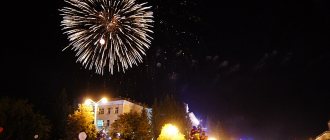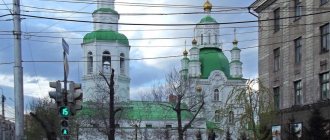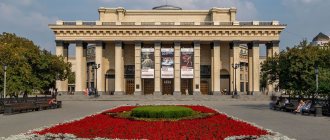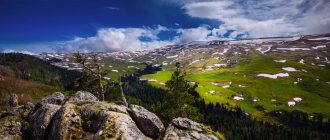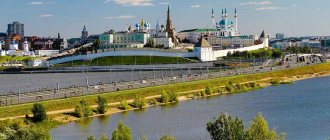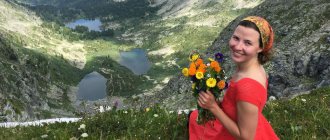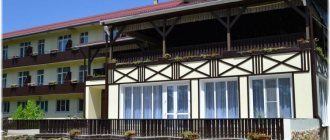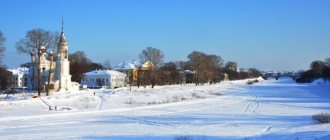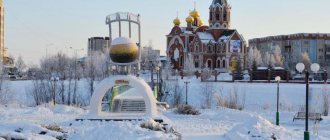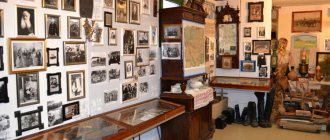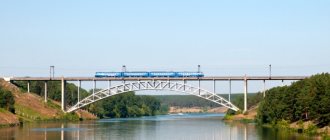Vologda is a beautiful and pleasant Russian city. Many come here on their own for a day and are convinced that it is not possible to see all the sights of Vologda in one day.
Vologda is an ancient city; it was first mentioned in chronicles in the same year as Moscow, i.e. in 1147. Ancient Vologda is a real tourist pearl, where a rich excursion program awaits you. There would be a desire! Magnificent wooden estates and old churches are scattered throughout the city. Also no less famous are Vologda lace, Vologda oil and carved palisades sung in a popular song. Churches in Vologda have been preserved in large numbers and represent different architectural styles - from Russian patterned to strict classicism. For lovers of historical buildings, the city center will be very interesting, where multi-colored domes, powerful walls and fancy architraves of picturesque wooden houses will appear before your eyes every now and then.
Kremlin Square and Vologda Kremlin
The Vologda Kremlin is the main attraction of Vologda, a historical and cultural center. It is located almost on the river bank. Kremlin Square is filled with some special energy. The ensemble surrounding the square includes three Orthodox churches, which are described below. Surprisingly, right up to 1947 this square was paved with wood, which in itself is extremely rare for the 20th century. But the first buildings here appeared under Ivan the Terrible. Thus, only for the 800th anniversary of the city, the area of the Vologda Kremlin was paved with stone.
The Vologda Kremlin arose during the reign of Ivan the Terrible; its history dates back to 1567. The Tsar of All Rus', fearing a revolt of the boyars in Moscow, was looking for a place for a reserve residence, and Vologda, in his opinion, was the best fit in this regard. In case of unrest, it is easy to get from Vologda to the North Dvina Sea Route and hide in Europe.
The Vologda Kremlin was built on a royal scale. Ivan the Terrible wanted it to even surpass the Moscow Kremlin. 20 defensive towers and massive walls surrounded by deep ditches with water rose above the city. However, in 1571, Ivan the Terrible left Vologda, and construction at that time was only half completed. As a result, the rest of the walls and towers were built, but from wood. The total length of the fortress walls exceeded 3 km.
The wooden part of the Kremlin suffered the most during raids and fires. In 1670, there was a strong spring flood that washed away part of the earthen ramparts. They did not restore the old walls and gradually their fortress began to be dismantled for building materials for houses and churches.
By 1820, most of the fortifications no longer existed and had lost their significance.
Today the Vologda Kremlin is called the complex of the Bishop's Court built in the mid-17th century, which includes the Simonovsky building, the Gavrilovsky building and the Iosifovsky building. They are the first residential stone buildings in Vologda.
The residence of the Vologda bishop was located here. The complex is built around the St. Sophia Cathedral. In 1671-1675, when the old Kremlin began to be dismantled into bricks, the Bishop's Court acquired its own towers and walls. Now the territory of the Bishop's Court is occupied by the Vologda Museum-Reserve.
St. Sophia Cathedral of Vologda
There are cathedrals with the name St. Sophia in different cities, including in Vologda. St. Sophia Cathedral with its bell tower is certainly the main attraction of the Vologda Kremlin (Bishops' Court).
Construction of the cathedral began in 1568, i.e. almost simultaneously with the construction of the Kremlin. The St. Sophia Cathedral was built in the likeness of the Moscow Assumption Cathedral, they even planned to name it the same. The main construction work was completed in 1570, however, Ivan the Terrible hesitated to consecrate the cathedral and let people into it. And a year later, plaster fell from the vault of the St. Sophia Cathedral directly onto the king’s head, which the autocrat immediately took as an assassination attempt. In the same year, Ivan the Terrible left Vologda, and St. Sophia Cathedral remained in an unfinished state for many years (until 1587).
Now St. Sophia Cathedral is the oldest stone building on the territory of Vologda. It is open to the public only in the summer and is also under the jurisdiction of the Vologda State Museum-Reserve.
The 78-meter bell tower of the Cathedral in pseudo-Gothic style is a real decoration of the entire ensemble of the Kremlin. The first three were made of wood, and the current one is already the fifth. The first stone bell tower was built in 1659. It is noteworthy that it was built from the very materials that were formed during the dismantling of the Kremlin walls. After 10 years, they decided to increase the height of the bell tower, for which the top of the bell tower was dismantled, and a new bell tower was built on the old foundation, which we now see in Vologda.
Access to the bell tower is open. The climb is quite difficult and long, which is compensated by wonderful views of the city from the observation deck.
Revolution square
The central square of Vologda is located within the historical district called Nizhny Posad. It arose in 1918 as a result of the unification of three squares - Sennaya, Spasskaya and Aleksandrovskaya.
Several churches were built here in the 17th century, but they were destroyed during the USSR. Today the square is decorated with monuments from the Soviet era: the Eternal Flame memorial and the stone monument to the Heroes of the Civil War, white and lonely, similar to a tooth, popularly called “The Tooth”.
Revolution Square is surrounded by very beautiful buildings.
Theaters
Drama Theater
The oldest regional theater in Vologda has existed since 1849. During this time, he changed several wooden buildings and addresses, while remaining at the epicenter of the city's cultural life. In the year of its 125th anniversary, the theater finally acquired its own home - a minimalist building made of glass and concrete.
The playbill presents plays by classics and modern authors: Gogol, Ostrovsky, Griboedov, Shakespeare, Alexievich, Heifetz and others.
Chamber Drama Theater
st.
Mira, 18 The non-state theater appeared in Vologda only 20 years ago, when the ambitious troupe of the Youth Theater decided to create a new creative association. For a long time, the actors played entertainment in rented venues until they were given their own building.
The chamber theater settled in an old two-story mansion. The poster includes works by domestic and foreign authors in original interpretations. Dramas, comedies and musicals regularly attract full houses.
Puppet theater "Teremok"
st. Lenina, 21
The children's puppet theater was founded in 1937. Recently it has occupied the building of the former church of Zosima and Savvaty Solovetsky. The architectural features of the building with a turret and kokoshniks on the windows are really associated with a fairytale tower - hence the name of the theater.
Performances are designed for audiences from 0 to 16 and older. For the little ones we offer timeless classics: “Thumbelina”, “The Frog Princess”, “Kolobok”. For older viewers and their parents, more serious productions: “Khanuma” by Tsagareli and “As You Like It” by Shakespeare.
Theater for Young Spectators
The Vologda Youth Theater was founded by theatrical standards recently - in 1976. For the first 4 years, the creative team wandered around cultural centers until they got their own premises. The actors were given the building of the Pushkin People's House, which previously housed the drama theater.
The Youth Theater has two halls at its disposal:
- The large one seats 425 spectators. It is equipped with a round rotating platform, a hold and hatches. In addition, there is a huge screen for projecting images.
- The small hall is designed for 88 people. It is used for original productions and chamber performances.
Resurrection Cathedral
The temple of the 18th century was built under Archbishop Joseph II the Golden. The building is in the Baroque style. The original painting has not been preserved, as the interior was renovated in the first half of the 19th century. Inactive between 1938 and 2016. Now it is again under the jurisdiction of the Russian Orthodox Church and regular services have been resumed there. The building is a valuable architectural monument and an object of cultural significance.
Alexander Nevsky Church
The Church of Alexander Nevsky is located next to the St. Sophia Cathedral on the Cathedral Square. Initially, the church was built in a different place; it was located opposite the Elias Monastery. In connection with the construction of the Vologda Kremlin, approximately in 1612, the church was moved to its current location.
The place where the Alexander Nevsky Church was moved was then called the Famous Mountain. Probably, reserves of lime were stored here, which was used in the construction of the walls of the Vologda Kremlin.
Until approximately 1782, the church remained wooden and suffered from fires more than once. When rebuilt in stone, the church almost completely retained its appearance, with the exception of the bell tower, which was originally a hipped roof. In the 1860s, the bell tower was replaced with a spire.
Church of the Intercession of the Virgin Mary at Torg
The Church of the Intercession on Torg was built in 1778 - 1780. on the site of another, more ancient wooden church of Joachim and Anna, which was the home church of Tsar Ivan the Terrible and was located inside the Kremlin. The use of the toponym “at Torgu” is apparently due to the fact that there was a large trading area nearby, which was the center of trade in the city.
The Church of the Intercession on Torg is made in the traditions of ancient Russian architecture: a simple, cubic shape with one dome, a low refectory with two domes and a low hipped bell tower. In the second half of the 19th century, a massive porch in pseudo-Russian style was added to the church. During Soviet times, the church was closed, but it has survived to this day without any significant reconstruction or damage.
Church of St. Nicholas the Wonderworker in Vladychnaya Sloboda
This temple, along with the St. Sophia Cathedral and the Church of Dmitry Prilutsky on Navolok, is considered one of the first stone buildings in Vologda. From an architectural point of view, it is not something outstanding; rather, it is a typical townsman temple, which was built everywhere in the 17th century. The interior space is decorated in the Baroque style with characteristic ornamental moldings, arches and vaults usually associated with this style.
List of historical and cultural monuments of the city of Vologda of regional significance
1. Monument to revolutionary I.V. Babushkina, park named after. 825th anniversary of the city of Vologda \Decision of the regional executive committee No. 146 of 04/06/88\ 2. Monument to the poet K.N. Batyushkova, Kremlevskaya Sq. \The same\ 3. Obelisk of the 800th anniversary of Vologda, 1959, on the right bank of the river. Vologda in the area of Burmagin and Udarnikov streets \Decision of the regional executive committee No. 328 of July 15, 1985\ 4. Obelisk of military glory to Vologda residents - Heroes of the Soviet Union, 1968, Kirov Square \Same\ 5. Memorial Eternal Flame of Glory, 1975 , pl. Revolutions \The same\ 6. Monument to participants of the Great October Socialist Revolution and Civil War, 1977, pl. Revolutions \The same\ 7. Tank T-34, in honor of the military and labor exploits of Vologda residents during the Second World War, 1975, st. Mira \Same\ 8. 85-mm anti-aircraft gun in honor of air defense soldiers of Vologda, st. Kalinina (now Zosimovskaya)\Same\ 9. IL-28 aircraft, in memory of aircraft designer S.V. Ilyushine, 1984, st. Ilyushin \The same\ 10. Bust of S.V. Ilyushina, 1977, at the intersection of st. Mira and st. Oktyabrskaya \Same\ 11. Monument to V.I. Lenin in the children's park, 1925, Children's park \The same\ 12. Monument to the USSR pilot-cosmonaut P.I. Belyaev, 1979, st. Maltseva \The same\ 13. Pushkin People's House, in which the revolutionary work of the Vologda group of the RSDLP was carried out in 1904-1905. and where M.I. performed in 1919 Kalinin, stone, Oktyabrskaya, 2 \Decision of the regional executive committee No. 760 dated 12/30/58\ 14. The building in which the GUBKOM RKP (b) was located in 1918, wooden, st. Oktyabrskaya, 11 \The same\ 15. The building of the provincial hospital, Sovetsky Ave., 59 \Decision of the regional executive committee No. 434 of 10/08/91\ 16. The building of the balneotherapy hospital, st. Turundaevskaya, 7 \Same\ 17. Building of the Vologda Pedagogical University, st. Orlova, 6 \The same\ 18. The building in which from 1925 to 1973. the editorial office of the newspaper “Red North” was located, st. M.I. Ulyanova, 9/2 \Same\ 19. Yakubova's house, 1852, wooden, st. Zasodimsky, 5 \Decision of the regional executive committee No. 257 of April 27, 1977\ 20. Theological seminary building, st. Lenina, 15 \Decision of the regional executive committee No. 434 of 10/08/91\ 21. The house in which from 1899-1912. lived the Soviet film director Vasilyev G.N. (1899-1946) and where in 1920 the lace makers’ artel was located, st. Lenina, 2/17 \Same\ 22. The house where the writer V.A. Gilyarovsky lived in 1878. (1853-1936), st. Chernyshevsky, 26 \The same\ 23. The house in which in 1867-1869. lived while in exile revolutionary democrat N.V. Shelgunov, st. Chernyshevsky, 13 \The same\ 24. The house in which in 1912-1914. lived while serving exile Ulyanova M.I. with mother Ulyanova M.A. and sister Elizarova-Ulyanova A.I., Sovetsky Ave., 16a \Decision of the regional executive committee No. 760 dated December 30, 1958\ 25. Samarin’s house, late 19th century, wooden, Sovetsky Ave., 16 \Decision of the regional executive committee No. 196 dated 04/15/74\ 26. Samarin House, early 20th century, wooden, Sovetsky Prospect, 16b \The same\ 27. Levin-Vatagin House, first half of the 19th century, wooden, Sovetsky Prospect, 18 \The same \ 28. The building of the Faculty of Technology of the Vologda Dairy Institute, created in 1911, village. Dairy, st. Shmidta, 2 \Decision of the regional executive committee No. 434 of 10/08/91\ 29. The grave of the poet N.M. Rubtsova (1936-1971), Poshekhonskoe cemetery \Same\ 30. Church of St. Nicholas on the Mountain, 18th century, stone, st. Burmaginykh, 17 \The same\ 31. Ensemble of the Gorne-Uspensky Monastery: \Post. CM of the RSFSR No. 1327 dated 08/30/60\ 32. Alekseevskaya Church, 1714, stone, st. Burmaginykh, 19a \Same\ 33. Abbot's house, 1825, stone, st. Mokhova, 52a \Decision of the regional executive committee No. 434 of 10/08/91\ 34. House for pupils of the monastery orphanage, 1873, stone, st. Mokhova, 52-a \Same\ 35. Gabriel Church, second half of the 18th century, stone, st. Burmaginykh, 30 \The same\ 36. Church of the Nativity of the Virgin, 19th century, Bogorodskoe cemetery, Govorovsky proezd, 2 \The same\ 37. Rogulin's house, 1912, wooden, st. Blagoveshchenskaya, 70 \Decision of the regional executive committee No. 257 dated April 27, 1977\ 38. Residential house, 1893, wooden, st. Varentsova, 1 \Decision of the regional executive committee No. 196 of April 15, 1974\ 39. Residential house, 1911, wooden, st. Vetoshkina, 3 \Decision of the regional executive committee No. 434 dated 10/08/91\ 40. Residential house, 1831, wooden, st. Vetoshkina, 10/56 \Same\ 41. House of Culture for Railway Workers, 1927, p/stone, st. Vetoshkina, 12 \Same\ 42. The building of the men's gymnasium, 18th century, stone, st. Galkinskaya, 1 \Post. SM RSFSR No. 1327 dated 08/30/60\ 43. Church of St. George, 18th century, stone, st. Gogol, 1 \Decision of the regional executive committee No. 434 dated 10/08/91\ 44. Residential house, 1914, wooden, st. Gogol, 36 \Decision of the regional executive committee No. 617 of October 18, 1977\ 45. Residential house, first half of the 19th century, wooden, st. Gogol, 46 \Same\ 46. Residential house, 19th century, wooden, st. Gogol, 52 \Decision of the regional executive committee No. 257 of April 27, 1977\ 47. House of Molchanov A.A. with a workshop, wooden, 1906, st. Gogol, 90 \Same\ 48. Lazarevskaya Church, 19th century, Gorbachevskoe cemetery, st. Burmaginykh, 50 \Decision of the regional executive committee No. 434 dated 10/08/91\ 49. Residential house, 19th century, wooden, st. Dobrolyubova, 4 \Decision of the regional executive committee No. 257 dated April 27, 1977\ 50. House of the Governor General, late XVIII-early XIX centuries, stone, st. Zasimovskaya, 1 \Decision of the regional executive committee No. 434 dated 10/08/91\ 51. Residential house, early 19th century, wooden, st. Zosimovskaya, 21 \Same\ 52. Residential house, third quarter of the 19th century, wooden, st. Zasodimsky, 9 (moved from Komsomolskaya St., 25/62) \Decision of the regional executive committee No. 257 of April 27, 1977\ 53. Nepein's house, 1908, wooden, st. Zasodimsky, 16 \Same\ 54. Sokolov's house, second half of the 19th century, wooden, st. Zasodimsky, 22 \The same\ 55. Stone bridge, 1789-1791, architect. Bortnikov P.T., b. Zolotukha \Decision of the regional executive committee No. 434 of 10/08/91\ 56. Vlasyevskaya Church, early 18th century, stone, st. Chelyuskintsev, 12 \The same\ 57. Kolesnikova's house, 1902, wooden, st. Kirova, 15 \Decision of the regional executive committee No. 617 of October 18, 1977\ 58. Kolesnikova’s house (main), late 19th century, st. Kirova, 17 \The same\ 59. Residential house, 1911. wooden, st. Komsomolskaya, 21 \Decision of the regional executive committee No. 257 dated April 27, 1977\ 60. Residential house, 19th century, stone, st. Lenina, 4 \Decision of the regional executive committee No. 434 dated 10/08/91\ 61. Residential house, 19th century, stone, st. Lenina, 5 \Same\ 62. School building, 19th century, stone, st. Lenina, 7 \Same\ 63. Residential house, 19th century, stone, st. Lenina, 9 \Same\ 64. Residential house, 19th century, stone, st. Lenina, 14 \Same\ 65. Governor's house, late 18th century, stone, st. Lenina, 19 \Post. CM of the RSFSR No. 1327 dated August 30, 1960\ 66. Guardhouse building, late 19th century, stone, st. Lenina, 19 \Decision of the regional executive committee No. 434 dated 10/08/91\ 67. Residential house, 19th century, wooden, st. Mayakovsky, 4 (moved from Herzen St., 7) \Decision of the regional executive committee No. 257 dated April 27, 1977\ 68. Residential house, 19th century, wooden, st. Mayakovskogo, 9 (moved from Dobrolyubova St., 18) \Same\ 69. Residential house, 19th century, wooden, st. Mayakovsky, 12 \Decision of the regional executive committee No. 617 of October 18, 1977\ 70. Outbuilding, 19th century, wooden, st. Mayakovsky, 12a \Same\ 71. Church of St. John the Evangelist, late 18th century, stone, st. Mayakovskogo, 16a \Regional Executive Committee Decision No. 434 dated 10/08/91\ 72. Residential house, 19th century, wooden, VI Armii Embankment, 41 \Regional Executive Committee Decision No. 617 dated 10/18/77\ 73. Residential house, late 18th century. , stone, Embankment of the VI Army, 81 \Decision of the regional executive committee No. 257 dated April 27, 1977\ 74. Rooming house, 1777, stone, Embankment of the VI Army, 87 \Post. CM of the RSFSR No. 1327 dated 08/30/60\ 75. Residential house, third quarter of the 19th century, wooden, VI Armii Embankment, 91 \Resolution of the regional executive committee No. 434 dated 10/08/91\ 76. Residential house, second quarter of the 19th century ., wooden, Embankment of the VI Army, 93 \Decision of the regional executive committee No. 434 of 08.10.91\ 77. House of provincial government (house of Admiral Barsh), 18th century, stone, Embankment of the VI Army, 101 \Post. SM RSFSR No. 1327 dated 08/30/60\ 78. House of a candle factory, 18th century, stone, Embankment of the VI Army, 111 \The same\ 79. House of Vitushechnikov, 1823, stone, Embankment of the VI Army, 131\To same\ 80. House of Varakin, XVIII century, Embankment of the VI Army, 137 \Same\ 81. Church of the Intercession at Market, 1778-1780, stone, st. Orlova, 5 \Decision of the regional executive committee No. 653 of November 16, 1978\ 82. Residential house, third quarter of the 19th century, wooden, st. Oktyabrskaya, 15 \Decision of the regional executive committee No. 239 dated 04/06/79\ 83. Residential house, second half of the 19th century, wooden, st. Oktyabrskaya, 17 \Same\ 84. Vladimirskaya Church (warm), 1685-1689, stone, st. Oktyabrskaya, 46 \Decision of the regional executive committee No. 434 dated 10/08/91\ 85. Residential house, 1880, wooden, st. Pervomaiskaya, 14 \The same\ 86. Restaurant “North”, beginning of the 20th century, Pobedy Ave., 6 \The same\ 87. Residential house, second half of the 19th century, stone, Pobedy Ave., 14 \The same\ 88. Trading house, early 20th century, Pobeda Ave., 25 \The same\ 89. Residential house, mid-19th century, Pobeda Ave., 26 \Regional Executive Committee decision No. 257 dated April 27, 1977\ 90. Residential house , late XIX - early XX centuries, wooden, Pobedy Ave., 32 \Same\ 91. Residential house, 19th century, wooden, st. Proletarskaya, 17 \The same\ 92. Church of the Nativity of the Virgin, late 19th century, stone, Prechistenskaya Embankment, 1 \Regional Executive Committee Decision No. 434 of 10/08/91\ 93. Residential house, 19th century, wooden, Prechistenskaya Embankment, " Golden Anchor", 1890-1891, in which from 1918-1920. the headquarters of the VI Army of the Northern Front was located, Sovetsky Ave., 6 \Order of the Council of Ministers of the RSFSR dated August 23, 1963. No. 3630-р\ 97. Building of the Passage Hotel, ser. XIX century, where battalions of the Red Guard were formed to fight the invaders in the North in 1919-1920, pl. Vozrozhdeniya, 2 \Order of the Council of Ministers of the RSFSR dated August 23, 1963. No. 3630-r\ 98. Residential house, first half of the 19th century, wooden, Sovetsky Ave., 48 \Same\ 99. Residential house, late 19th century, wooden, Torgovaya Square, 5 \Same\ 100. Residential house, late 19th century, wooden, Torgovaya sq., 9 \The same\ 101. Residential house, late 19th century, wooden, Torgovaya sq., 13 \The same\ 102. Residential house, late 19th century ., wooden, Torgovaya sq., 15 \Same\ 103. Residential house, 1912, wooden, st. Udarnikov, 10 \Decision of the regional executive committee No. 257 dated April 27, 1977\ 104. Hotel "Hermitage", early twentieth century, stone, st. M. Ulyanova, 4 \Decision of the regional executive committee No. 434 of 10/08/91\ 105. Shopping arcades, 19th century, stone, st. M. Ulyanova, 6 \Same\ 106. Administrative building, 20th century, stone, st. M. Ulyanova, 7 \Same\ 107. Administrative building, 19th century, stone, st. M. Ulyanova, 8 \Same\ 108. Residential house, second half of the 19th century, stone, st. M. Ulyanova, 11 \Same\ 109. Residential house, 19th century, st. M. Ulyanova, 13 \Same\ 110. Residential house, XIX century, st. M. Ulyanova, 15 \Same\ 111. Residential house, 19th century, st. M. Ulyanova, 21 \Same\ 112. Building, XIX century, st. M. Ulyanova, 23 \Same\ 113. Residential house, late XIX - early XX centuries, wooden, st. Chernyshevsky, 2 \The same\ 114. Residential house, 1867, half-stone, st. Chernyshevsky, 11 \Same\ 115. Residential house, late XIX - early XX centuries, wooden, st. Chernyshevsky, 28 \Same\ 116. Residential house, second half of the 19th century, wooden, st. Chernyshevsky, 37 \Same\ 117. Residential house, late XIX - early XX centuries, wooden, st. Chernyshevsky, 42 \Same\ 118. Residential house, early 20th century.. st. Chernyshevsky, 55 \The same\ 119. Church of Antipius, second half of the 18th century, stone, lane. Chernyshevsky, 10 \Same\ 120. Lavrov's house, 1872, wooden, st. Engelsa, 11 \Decision of the regional executive committee No. 257 dated April 27, 1977\ 121. Lavrov's house, 1902, wooden, st. Engelsa, 11a \Same\ 122. Residential house, early 19th century, wooden, st. Engelsa, 33 \Decision of the regional executive committee No. 617 of October 18, 1977\ 123. Church of Alexander Nevsky, XVIII century, stone, st. Orlova, 10 \Decision of the regional executive committee No. 653 of November 16, 1978\ 124. Mansion, 1908, wooden, st. Engelsa, 39 \Decision of the regional executive committee No. 196 of April 15, 1974\ 125. Residential house, early 19th century, st. Gogol, 96 \Decision of the regional executive committee No. 617 of October 18, 1977\ 126. Residential house, late 18th century, st. Orlova, 15 \Decision of the regional executive committee No. 434 of October 8, 1991\ 127. Gravestone monument to Kh.S. Ledentsov - an ascetic of Russian science, Vvedenskoye cemetery \Decision of the regional executive committee No. 418 of October 4, 1988\
Church of the Intercession on Kozlen
The church building is made in the Moscow Baroque style and was built in 1710. Unique frescoes created by masters of the Yaroslavl school have been preserved here. Later paintings date back to the 19th – early 20th centuries. The first mention of this church dates back to 1612. According to the surviving data, there was previously another temple on this site, but it was burned by Lithuanian invaders during the Time of Troubles.
Temple of Constantine and Helena
A picturesque church of the late 17th century, built in the style of Russian patterning, characteristic of Moscow. This style was distinguished by the presence of five domes crowning a quadrangle on an extensive basement, and a tent-shaped bell tower of several tiers. Icons from the 15th to 18th centuries have been preserved in the temple. It is believed that it was also built on the site of an earlier structure - a wooden church erected under Ivan III.
Monument to the letter "O"
Vologda residents are okaya in conversation. A monument to this feature of the townspeople in the form of a metal letter was erected in 2012 in the city park on Cathedral Hill near the Kremlin Square. The height of the capital letter “O”, decorated with traditional northern ornaments, is 2.5 m.
Monument to the letter "O"
The idea of installing the original monument belonged to students of the Vologda Institute of Business, after which a competition was announced among students of the Vologda school. The winning project was brought to life with a two-week effort by six blacksmiths. The monument was opened on the city day, when the 865th anniversary of Vologda was celebrated. Over the past years, a tradition has developed of photographing newlyweds inside a letter that acts as a frame.
Spaso-Prilutsky Monastery
A monastery dating back to the 14th century. Founded by the student and associate of Sergius of Radonezh, St. Dmitry Prilutsky. The monastery is one of the most revered and ancient in the Russian North. Its complex includes architectural monuments of the 16th-18th centuries. 1926 was a turning point for the monastery - it was closed, and in the 1930s it was even used as a prison. In 1992, the monastery was returned to believers.
Gorne-Uspensky Monastery
Convent for women from 1590 to 1924. It was founded by Domnicia, a nun and old woman.
Initially, all the buildings were wooden; the first stone structure was erected in the second half of the 17th century. In the 19th century, a school and shelter were opened at the monastery. This monastery is currently under restoration, some parts of it have been completely restored, while others have been lost forever.
A few facts about Vologda
- The city of Vologda was first mentioned in 1147 , which is considered the official year of its foundation.
- The name of the city translates as “clean water”.
- 224 historical, architectural, and cultural monuments are registered here, 128 of which are protected by the state.
- On an area of 116 sq. km. Home to about 313 thousand people.
- The distance to Moscow is 450 km, to Cherepovets - 145 km, to the homeland of Father Frost Veliky Ustyug - 450 km.
- Vologda is famous for its original dialect.
- The city became famous for the famous Vologda lace and is considered the lace capital of Russia.
- Vologda is famous for Vologda butter, which has a special taste and aroma.
- Vologda is included in the Silver Necklace of Russia and is a popular tourist city.
Museum "World of Forgotten Things"
In this museum you will find an exhibition dedicated to pre-revolutionary Vologda, the culture and life of various segments of the urban population of that time. The halls display 19th-century interiors and various items common in pre-revolutionary houses. The extensive collection is located on three floors, it consists of old photographs, family heirlooms, furniture, and interior items.
House-Museum of Peter I
Website: www.vologdamuseum.ru Address: Sovetsky Prospekt, 47. Opening hours: from 10.00 to 17.30, closed on Monday and Tuesday.
This building was owned by the merchant Vitusheshnikov until 1872, but the city authorities bought it.
Since 1885, there has been an exhibition dedicated to Peter the Great here. The following exhibits are of interest to visitors: a death mask, Peter’s robe, and other exclusive items. Also here you can get acquainted with the everyday life of the Slavs who lived in these places in the 17th-18th centuries.
Museum "Vologda Link"
In Tsarist Russia, one of the places where prisoners were exiled was Vologda. In modern times, or rather in 2007, in a wooden house on the street. Maria Ulyanova opened a museum dedicated to this phenomenon. In the building where the museum is opened, in 1911-12, the future leader of the Soviet people, known to us as I.V. Stalin, lived for several months in 1911-12. He was also in exile in Vologda. The exhibition tells about famous political prisoners and their activities.
Cultural attractions and museums
House-Museum of Peter I
Sovetsky Prospekt, 47
The squat house of Peter I is an architectural monument of the 17th century, surrounded by a shady park. During his visits to Vologda, the Tsar stayed in this house 5 times.
In 1872, a museum dedicated to the emperor was opened here. The most valuable exhibits: the clothes of Peter I, his death mask, two Dutch chairs and a mirror - an attribute of royal power.
Vologda Museum-Reserve
In addition to the Vologda Kremlin and the Bishop's Compound, where the main historical values are located, the main museum complex of the region includes 9 more branches.
The funds number over 1 million units. These are handicrafts, icons and church utensils from lost churches, paintings, sculpture, mineral collections, numismatics, furniture and household items from noble estates.
The main exhibitions of the Vologda Museum-Reserve are:
- icons created by Vologda masters during the period of the 16th-19th centuries;
- wooden sculptures and carvings: bas-reliefs, iconostases, etc.;
- fine art of the 17th-20th centuries (graphics, portraits, paintings);
- household, lace and religious fabrics.
Exhibition complex “Vologda at the turn of the 19th-20th centuries”
The branch of the Vologda Museum-Reserve occupies 3 wooden houses: a merchant estate, an apartment building and a shop. Once upon a time this entire complex of buildings belonged to the merchant Samarin.
In 1913-1914, Lenin’s younger sister Maria rented an apartment in an apartment building. A memorial museum dedicated to the revolutionary was opened in 1968, but it existed only until Perestroika.
In the 2000s, new exhibitions gradually began to appear. The following exhibitions are currently available:
- “Photo for memory” - rare photographs of Vologda 200 years ago.
- “Old School” - the history of education, the structure of primary schools and secondary educational institutions in the Vologda region.
- “Traditions of the Russian feast” - the culture of hospitality, examples of everyday and festive table settings.
- “Relics of the Samarin House” - photographs from the family archive, personal belongings and household items of the merchant family.
The museum has a showroom, a souvenir shop with handicrafts, and a photo studio where you can take photographs in ancient costumes.
Art Gallery
The Vologda Gallery, founded in 1952, contains over 30,000 exhibits. The extensive collection is divided between 4 branches.
- The largest part of the collection, represented by contemporary Russian art, is exhibited in the Resurrection Cathedral.
- The Shalamovsky House, a two-story mansion from the 18th century, displays a collection of Western European and Russian paintings.
Another 2 exhibitions are dedicated to specific persons: one is based in the Korbakov House, the other in the workshop of A. Panteleev.
Museum "World of Forgotten Things"
st.
Leningradskaya, 6 The buildings that occupy the museums of Vologda are attractions in themselves. One of these buildings is a wooden mansion built by the merchant Panteleev in the mid-19th century in the spirit of late classicism.
Inside there is a museum “The World of Forgotten Things”, which has 2 permanent exhibitions:
- On the ground floor, the interiors of the Vologda nobles of the 19th - early 20th centuries were recreated (living room, study and dining room).
- The second exhibits portraits of local nobility of the 18th-19th centuries.
The mezzanine is reserved for temporary thematic exhibitions, which present rarities from private family collections.
Architectural and Ethnographic Museum "Semenkovo"
village Semenkovo
If you are looking for something to see in the vicinity of Vologda, be sure to include the Semyonkovo Museum in your route. This is an open-air ethnographic complex located just 14 km from the regional center.
Monuments of wooden architecture from the mid-19th – early 20th centuries are collected on an area of about 13 hectares. These are peasant houses, baths, forges, barns and other buildings. The pearls of the reserve are the windmill and the chapel of Elijah the Prophet.
A simple rural life has been recreated inside some buildings. Celebrations and thematic performances are often held on the territory of the reserve.
Museum "Vologda Link"
st. Maria Ulyanova, 33
In the pre-revolutionary era, Vologda was a place of exile for unreliable freethinkers. Historians believe that over 10,000 people visited here - mostly representatives of the creative intelligentsia. The thematic museum “Vologda Link” is dedicated to the events of those years.
The permanent exhibition in a two-story wooden house opened in 1937. Initially, it was entirely dedicated to Stalin, who was also serving exile in Vologda. Later, the exhibition was transformed into the “House-Museum of the Revolutionary Activities of the Bolsheviks in Vologda Exile,” and then was completely closed.
The rebirth of the museum took place in 2007. Now here you can learn about the life of exiles. In small rooms, the furnishings of the 19th and early 20th centuries are recreated, photographs, important documents, as well as personal belongings of oppositionists and gendarmes are exhibited.
Entertaining Einstein Science Museum
st. Leningradskaya, 79
Among the attractions of Vologda there are some very unusual ones - for example, the Einstein Museum, created mainly for children. Although it will be interesting for adults too. Visitors are invited to become full participants in scientific shows and experiments. All exhibits can be touched, launched and turned on.
Literally creating a storm in a glass, learning to control lightning, finding yourself inside a soap bubble, making a battery out of an apple - this is not a complete list of available scientific activities. They also conduct quests and master classes based on popular children's films and books.
Museum "Literature. Art. Century XX"
The museum is located on the territory of the former mansion of the merchant Sitnikov, which belongs to the monuments of Vologda wooden architecture of the 19th century. The collection is entirely dedicated to the life and work of two artists: composer V. A. Gavrilin and poet N. M. Rubtsov, who dedicated many of their works to the Russian North. The collection is a branch of the Vologda Museum-Reserve.
Bishop's Court
In the Bishop's Court, formerly called the "small Kremlin", from the middle of the 16th century. until the beginning of the 20th century. Vologda bishops lived. The oldest buildings of the courtyard are contemporaries of the Kremlin: for example, the Economic Building, otherwise called the State Prikaz, was built in 1659. It is the oldest surviving stone building in Vologda.
Later, the Simonovsky building with the Cross Chamber (the first stone residence of the bishop), the Nativity Church, then the Gavrilovsky building, from which Ierenevsky later separated, and the Gate Church were erected. Already in the 18th century. The Consistory Building and the Cathedral of the Resurrection were built. The latest building, the Joseph the Golden building, was built in the style of St. Petersburg classicism.
The current Bishop's Courtyard, also called the Cathedral Hill, is surrounded by stone walls 550 m long, in the corners of which there is the Resurrection Cathedral and three towers. Inside the courtyard are the chambers of bishops, the house Nativity Church and other buildings. The Holy Gate leads to the St. Sophia Cathedral located to the north.
Bishop's Court
From 1923 to this day, the Bishop's Court has been part of the main museum complex of the city - the Vologda Museum-Reserve.
Address: st. Sergeya Orlova, 15. Directions; by buses No. 7, 8, 11, 16, 22, 27, 29, 32, 37, 42 to the stops “Leningradskaya” or “Center (Torgovaya Ploshchad)” or No. 4, 14, 38 to the stop “Center (Torgovaya Ploshchad)” )". The same buses can also take you to the St. Sophia and Resurrection Cathedrals located in the immediate vicinity, as well as to the Alexander Nevsky Church.
Vologda wooden architecture
In Vologda, not only the city's wooden buildings have been preserved; there are many unique houses and their condition is often quite decent. These houses are included in the list of attractions of Vologda and are a must see!
By the beginning of the 21st century, there were from 105 to 170 wooden architectural monuments in Vologda, dating from the 18th – 20th centuries. These are noble, merchant, and bourgeois houses, made in such architectural styles as classicism, empire and modern.
Many examples of Vologda wooden architecture can be found near the Kremlin. There are many such houses on Leningradskaya Street .
Also take a look at Blagoveshchenskaya Street (previously called Klara Zetkin). this is a real treasure trove of wooden houses in Vologda. On this street there are several outstanding monuments of wooden architecture and a monument to a carved palisade.
Parks and walking areas
Botanical Garden Botanika
In 2016, a garden was opened in Vologda, which united the world of flora and fauna on its territory. The area of the complex is over 2,200 m2. More than 300 species of plants from all over the world feel comfortable here, including exotic ones: breadfruit, mango, papaya and several varieties of palm trees. The oldest one, Hamerops, is confidently approaching its 100th anniversary.
Flowers, trees and herbs are grouped by region of origin: Asia, Africa, North America, Australia and Desert. A tour of the green planet in miniature will bring real aesthetic pleasure.
Orchid Museum in the world today . It presents many types of these flowers: from common to the rarest.
Another local attraction is the Butterfly Garden . Bright beauties of more than 30 species flutter through it, living in the tropical jungles of Africa and Southeast Asia.
Finally, you should check out the mini zoo . Its inhabitants include reptiles, primates, birds and pets. The favorite of visitors is the dwarf American pony.
Peace Park
One of the largest parks in the city covers an area of over 155 hectares. It was founded in 1939, and received its symbolic name after the victory in the Great Patriotic War.
The vast green area has several recreation areas: children's and sports grounds, attractions, and even a small beach. For those who like long walks, there are health routes (the main one runs along the Central Alley).
A stone bridge
The Stone Bridge is the shortest (about 100 m) and only pedestrian street in Vologda. This is a real bridge connecting the banks of the Zolotukha River.
It was built at the end of the 18th century according to the design of the architect Bortnikov. Later, the ensemble was supplemented by 4 towers of three floors - on the north and south sides. In the 1820s, shopping arcades were added to all the towers, but due to the construction of the Hermitage and Passage hotels, the two southern towers were dismantled.
85 years ago, the stone bridge was restored, and stone fences were installed on the sides, turning it into a promenade. Now lovers make dates here and street performers perform here.
Kremlin Garden
Also known as VRZ Park, the Kremlin Garden is considered a favorite vacation spot for city residents. 17 species of trees and 11 species of shrubs were planted on an area of almost 4 hectares. But the special pride of the garden is its system of ponds.
The park has attractions, a children's playground and a dance floor. Excellent photographs are taken against the backdrop of the original sculptures “Forged Boat”, “Heart of Vologda” and “Mill of Happiness”.
In the garden there is a chapel of the Vladimir Icon of the Mother of God. A beautiful building in the style of ancient Russian architecture appeared here in 2002.
Labor Veterans Park
Initially, this place was called “Zarechensky Garden” - after the district of the city. The park was founded on a vacant lot on the initiative of labor veterans and pensioners. 13 species of trees and 8 species of shrubs were planted in the cleared and landscaped area.
Today, the recreational zone occupies an area of over 9 hectares, on which attractions, children's playgrounds and sports grounds are located. In the center there is a monument to home front workers who worked for the benefit of victory during the Great Patriotic War.
In the depths of the shady alleys there is a pond. It is not suitable for swimming, but you can feed the ducks living here - the birds are always happy to be treated.
Verkhny Posad
Verkhny Posad is the oldest part of Vologda, on the territory of which there are a considerable number of interesting and significant historical attractions. It was from Verkhniy Posad that the history of Vologda began.
It is believed that already in 1147 the Kyiv monk Gerasim founded a monastery here, which gave rise to the city. The current Kremlin is not the first, by the way. In 1461, the city became the capital of an appanage principality, and it was then that the Vologda Kremlin-fortress was erected, which existed until Ivan the Terrible. In 1567, by order of Ivan the Terrible, construction of a new fortress began. And the old Vologda Kremlin gradually became unnecessary and was dismantled.
Wooden houses in Verkhny Posad
Wooden houses are perhaps the main attraction of Vologda. In Verkhny Posad, as well as near the Kremlin, you can find many of these beautiful carved wooden houses.
Take a look at the Carved Palisade Center for Folk Arts and Crafts. The center hosts creative meetings with masters; lectures on topics related to the folk culture of the Vologda region, historical and archaeological discoveries, etc.
Many beautiful houses are ordinary residential buildings. It’s nice that residents maintain the historical heritage of their city in decent condition.
Monuments of Vologda
In the area of the Vologda Kremlin you can find almost all the most interesting monuments in Vologda.
“Door to Vologda” in 2014 became a gift to the city from participants in the “City of Crafts” festival.
Bench “Let’s sit and eat”
Dedicated to the famous Vologda dialect. Since 2015, this bench has become almost the calling card of the whole of Vologda. All visitors love to take pictures here, because the view from the observation deck is simply excellent.
The monument to the letter “O” , erected in 2012, just like the bench, is intended to perpetuate the Vologda Okanye.
Forged Rook
In the Kremlin Park you can find more than one art object, including the Forged Rook. A beautiful monument worth taking a photo with.
Monument to the Russian poet K. N. Batyushkov. It was installed on Kremlin Square in 1987. It is noteworthy that next to the figure of Konstantin Nikolaevich the sculptor installed a large horse. The composition also included Pallas Athena and Muse in the image of a Vologda peasant girl with a pipe (they can be found nearby).
"Bench of Reconciliation"
The bench is made for people in a quarrel; sitting on opposite sides, it will definitely bring you together. On the top of the bench - the shape of palms, if you have made peace - secure it and attach your palm to the bench. Address: Blagoveshchenskaya street, 24.
The monument to the Govorun bird is located on the territory of the historical Trade Square, and, at the same time, opposite the building of the Pedagogical University, since “The Govorun bird is distinguished by its intelligence and intelligence.”
What to try and where to eat in Vologda
Cafes, restaurants and snack bars of Vologda
The choice of establishments in Vologda is quite large. As they say in such cases - for every taste and budget. I will only tell you about the places I have personally visited. Let's start with the most budget establishments, which can be described as a cafe-dining room. A canteen because it is self-service, a cafe because the range and prices are still closer to higher-class establishments.
Cafe “Mac Duck” at the Spasskaya Hotel
st. Oktyabrskaya, 25
I’ll tell you about the hotel a little later, about the restaurant too, now only about the cafe. A three-course lunch plus compote will cost 300-350 rubles. Here you can choose dishes from an assortment that, although only at first glance seems large. In fact, everything is about the same. For example, there is meat with mayonnaise, and there is cheese, or both. Salads are mainly variations on the Olivier theme and always with mayonnaise. In general, everything is a solid C grade.
Cafe “Red Bridge”
st. Embankment 6 Armii, 143
This cafe is located on the opposite side of the Vologda River from the Kremlin near the pedestrian bridge, which, by the way, offers probably the most interesting view of the city. I noticed the cafe for myself on my first visit to the Vologda region and noticed that Vologda residents come here for lunch. This is always an indicator of good and most importantly stable quality of food.
In general, as a lunch place it is highly recommended to visit. It is unlikely that you will be able to have dinner here, since the establishment closes at 17:00. Moreover, there are other establishments for dinner, which are discussed below.
Club-restaurant “Spassky”
st. Oktyabrskaya, 25
Restaurant at the Spasskaya Hotel. By the way, the hotel has several other establishments such as a bar, a coffee shop and a pub, but all of this operates according to a schedule known to the owner of the establishments. In addition, the restaurant often hosts various corporate events and banquets.
The cuisine and interior are fancy, but the quality of the food is average and the price is above average. In general, this entire huge complex called “Spasskaya” is extremely popular among local residents and they treat it with reverence, although there is no particular reason for this. Apparently the Soviet past also plays a role, when this hotel and restaurant was almost the only place where foreigners were brought. In general, it only makes sense to come here if you are staying at Spasskaya, but don’t want to go out into the city.
Restaurant “Drova”
Embankment 6 Armii, 159A
We return to the Red Bridge again, the “Drova” restaurant is located on the same embankment as the mentioned “Red Bridge” cafe. Modern interior and modern kitchen, good presentation.
View this post on Instagram
A post shared by Restaurant “Drova” | Vologda (@restoran_drova)
Tasty, prices are slightly above average, positioned as a family establishment. During the day there are good and very inexpensive business lunches. In general, quite recommended, rating 4+.
Restaurant “Sever”
ave. Pobeda, 6
A restaurant with history, so to speak. It is considered the first restaurant in Vologda and has existed for more than 50 years. Restaurant “Sever” is the case when you can enjoy truly interesting dishes of Russian cuisine. There is also sturgeon and pancakes with caviar accompanied by Vologda vodka and bear meat cutlets, and the cranberry juice is good here. Overall, this is a good place to spend an evening.
Restaurant “Seven Evenings”
Pobeda Ave., 13
Located directly opposite “North”. By the way, there are a lot of establishments on Pobedy Avenue, but I promised to tell only about those that I have personally visited, so you can try others yourself and tell them in the comments. Let's return to “Seven Evenings”. I returned here every time I was in Vologda and never regretted it. Nice interior and staff. Dishes of Russian cuisine, but in an original presentation. During the day they offer excellent set lunches - maximum price 350 rubles. In general, out of the whole set, for me, this is the best restaurant in Vologda that I have ever been to.

